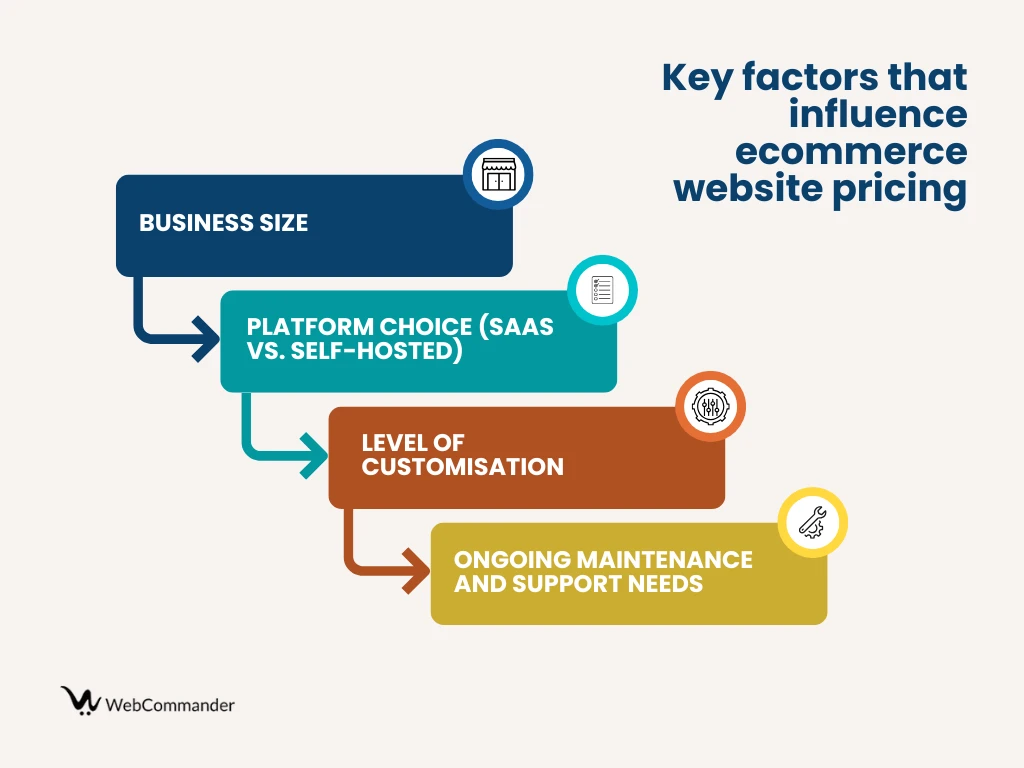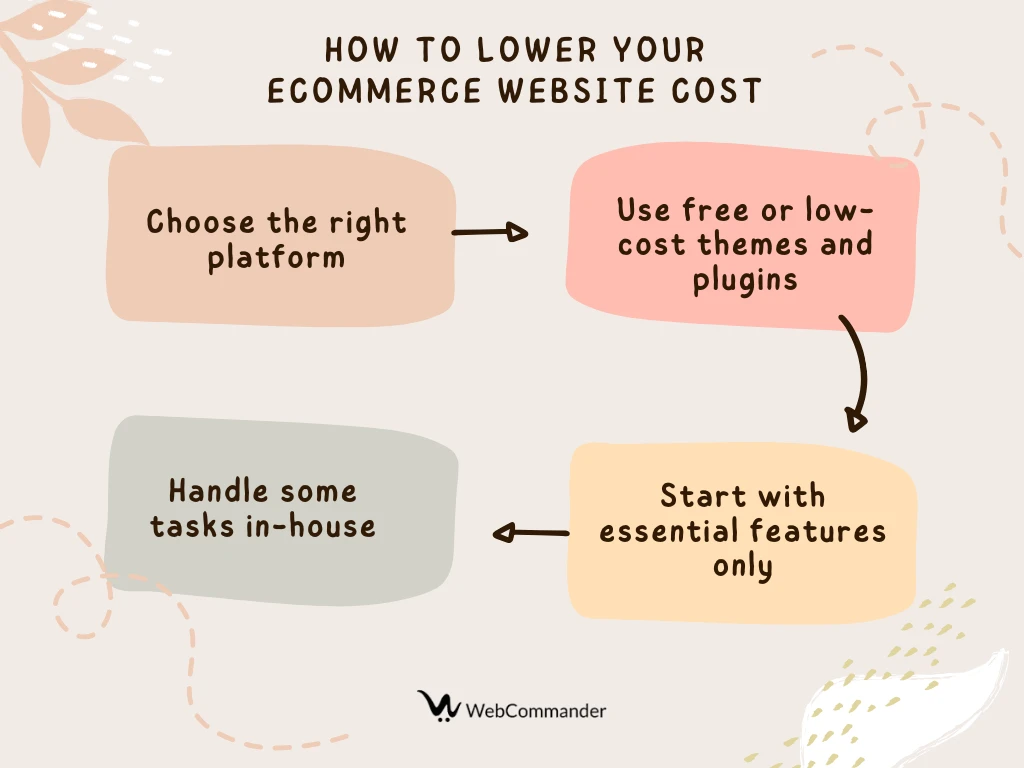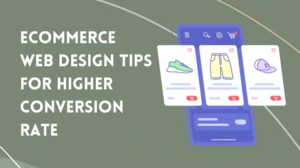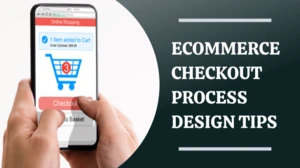Ecommerce Website Cost | True Cost of Running an Ecommerce Store
Having an ecommerce website sounds simple; you just set it up, list the products and start selling, all while skipping the cost of a physical shop. But there's more to it than just creating a site. There are a bunch of costs that can sneak up on you.
Not just the basics like buying a domain name, paying for hosting and picking a theme, there are many extra expenses that come from extra plugins, apps or campaigns.
So, the key is to know what to expect from the start and understand all the costs.
In this article, we will break down the costs associated with building an ecommerce website and take a look at what you should consider before you make any decisions.
How much does an ecommerce website really cost?
Let's do an example breakdown of initial setup costs for creating an ecommerce website.
| Items | Estimates cost range |
| Domain name | $10 – $20 per year |
| Website hosting | $100 – $500 per year |
| SSL certificate | $0 – $200 per year |
| Ecommerce platform fee | $5 – $350 per month |
| Theme | $0 – $200 one time |
| Website design and development | $500 – $10000 one time |
| Plugins and extensions | $30 – $500 per year |
| Payment processing fees | 2% - 3% per transaction |
| Marketing and SEO tools | $50 – $500 pet month |
All this example just shows the typical range of costs, even for a relatively simple store. As your business grows, you will definitely face additional expenses like advanced analytics tools, premium shipping integrations, custom development work and more.
Breaking down the detailed cost components
Domain name
Your domain name is basically your store's address on the internet, such as yourbrand.com. Standard domains are usually inexpensive, costing around $10–$20 per year, whereas for the highly competitive or premium domain names, you have to invest more.
For example, the short, memorable, and highly brandable domains that come with popular keywords or are already owned and sold on the aftermarket can run into hundreds or even thousands of dollars. Even renewal rates can also be higher than the first-year promotional price.
Website hosting
Website hosting is the service that stores your website's files and makes them accessible to visitors. The cost usually depends on the type of hosting you are choosing and the traffic level of your store.
If you need limited performance, shared hosting that typically costs $60-$180 per year is the cheapest option. Or for your high-traffic and resource-intensive store, you choose a software-as-a-service (SaaS) ecommerce platform or managed hosting services.
SSL certificate
It is essential for ecommerce as it encrypts the data exchanged between your site and your customers. It is necessary as it protects your sensitive information, such as credit card details. Otherwise, your site will be shown as "Not secure" and end up scaring off your potential buyers.
There are many hosting providers that include a free SSL certificate. But some businesses opt for paid certificates as well, which can range from $50 to $150 per year.
Ecommerce platform fees
The ecommerce platform you choose has a major influence on your budget. Subscription-based platforms like Shopify, BigCommerce, and Wix charge a recurring monthly fee, which usually starts at around $29 and can exceed $300 per month if you choose advanced plans. These platforms provide you with features like more staff accounts, advanced reporting, or lower transaction fees.
There are many open-source platforms, such as WooCommerce or Magento, which are free to download, but they are not truly "free". You have to pay for hosting, themes, plugins, and possibly a developer to set them up and maintain them.
Theme or template
Many platforms offer simple and functional free themes that work as a good starting point for smaller budgets. There are premium themes, on the other hand, that typically cost between $50 and $250. They come with more design flexibility, better performance, and additional built-in features. There are many businesses that opt for a fully custom design, which can be significantly more expensive.
Design & development
This is one of the largest upfront costs in creating an ecommerce site. For small stores using standard themes, design and development costs might range from $500 to $1,000. It will cover the setup cost, branding tweaks, and basic functionality.
But for a fully customised ecommerce site with unique layouts, interactive elements, and complex integrations, it can easily cost $5,000 or more. These costs can expand further if you need special features like multi-language support, custom checkout flows, or deep integrations with third-party tools. Though it seems tempting to cut costs here, investing in a professional build can let you avoid technical issues and costly redesigns later.
Plugins & extensions
Plugins and extensions add extra functionality to the ecommerce store. For example, you can install a plugin for advanced product filtering, subscription management, or custom shipping rates. Many platforms offer free options, but premium plugins often cost between $50 and $500 per year, based on the complexity and licensing terms.
There are many open-source platforms that typically require more plugins to match the built-in features of a SaaS platform, while hosted solutions like Shopify might require fewer. But they often charge recurring app subscription fees.
Payment processing fees
Every time a customer purchases a thing from you, your payment gateway charges a small percentage of the sale. This fee usually falls between 2% and 3% per transaction, plus a fixed charge depending on the provider.
There are popular options like PayPal, Stripe, and Square that charge similar rates. Also, there are some platforms that offer discounted rates if you process payments through their own system.
Marketing & SEO tools
Most of the businesses are likely to invest in marketing and SEO tools. These might include email marketing platforms, social media scheduling tools, keyword research software, or paid advertising channels like Google Ads and Facebook Ads. All these costs can vary widely, as you can spend $50 per month on basic marketing software or several hundred dollars monthly to run multiple campaigns and use premium tools.
Investing in the right tools can help you target the right audience, track campaign performance, and optimise your content for better search engine visibility.
4 Key factors that influence ecommerce website pricing

1. Business size
The size of your business is one of the primary factors that will influence your ecommerce costs. A small store that has only a handful of products and low traffic will require less server capacity, fewer design elements, and minimal functionality. This will make it cheaper to set up and maintain.
On the other hand, a large store with hundreds or thousands of products, high traffic, multiple categories, and complex checkout processes will require more robust hosting, additional features, and more custom development, which will boost the costs significantly.
2. Platform choice (SaaS vs. Self-Hosted)
The ecommerce platform you select plays a major role in determining your budget. SaaS platforms like Shopify, BigCommerce, or Squarespace charge a fixed monthly subscription and typically cover hosting, security, and maintenance. If you choose SaaS platforms, the costs can be predictable.
But if you go for self-hosted platforms, these will be free to install, but you need to pay separately for hosting, security, themes, and ongoing maintenance.
3. Level of customisation
How much you want to customise your store will affect the overall costs. If you are using a pre-built template or theme, it will be the most cost-effective option. But if you need a fully custom design that has to match your brand and unique user experience, it will require more development time and a higher upfront investment.
By customisation, you can include bespoke layouts, interactive features, animations, and brand-specific elements that enhance usability and conversion rates, but each adds to your total cost.
4. Ongoing maintenance and support needs
Even after your ecommerce site is live, costs will vary depending on the maintenance, updates, and support you need. Regular maintenance will help your store run smoothly, stay secure, and remain compatible with updates to your platform or plugins. You may even need technical support, bug fixes, or occasional redesigns.
If you skip these ongoing needs, it can lead to security vulnerabilities, downtime, or costly emergency fixes. So, it's important to factor them into your overall cost planning.
There are some additional costs that can arise depending on your store's needs:
- High-quality photography and videography
- Marketing and advertising campaigns
- Multi-currency support
- Premium plugins and apps
- Custom branding
- Advanced analytics and reporting tools
- Training and staff onboarding costs
4 ways to lower your ecommerce website cost

1. Choose the right platform
One of the smartest choices is to choose the right one that matches your current needs. Whether you're planning to go for a simple, ready-to-use SaaS solution or a fully customisable platform, make sure it offers the features, integrations, and scalability your business requires.
Here are some questions you can look for to keep the costs low.
- What are the total costs involved, including everything from setup to monthly fees to transaction fees?
- Is the platform mobile-friendly and optimised for speed?
- Does it have built-in SEO tools and security features?
- Does it allow integration with marketing tools like email marketing or social media scheduling?
- Does the platform allow customisation?
2. Use free or low-cost themes and plugins
This is a smart way if you want to keep your ecommerce website expenses under control. There are many platforms that offer a wide selection of professionally designed free themes to give your store a polished and user-friendly look. Also, there are plenty of budget-friendly and free plugins available in the market that you can use to add essential features.
But you have to make sure that these themes and plugins are from reputable sources in order to maintain security and performance.
3. Start with essential features only
It will help you to launch your ecommerce store quickly while keeping the costs and complexity low. Don't invest your time and money in advanced tools or custom functionalities that you may not need right away.
Rather, focus on the must-have core elements like a clean product catalogue, secure payment processing, and mobile-friendly design. Later, when your business grows, you can gradually add more advanced features based on your real needs.
4. Handle some tasks in-house
If you handle some of the basic tasks in-house, you can easily save money, especially in the early stages of running your ecommerce store. Instead of outsourcing everything to agencies or freelancers, take control of manageable tasks like writing product descriptions, creating blog content, performing basic SEO (such as adding keywords and meta descriptions), or managing your social media pages. There are plenty of free resources and tools available that you can take help from.
Comparing ecommerce platforms: Which one fits your budget?
Below is a quick comparison of some of the most popular platforms. Get a clearer picture of how they stack up.
| Platform | Starting cost | Highest standard plan | Other costs to consider |
| Shopify | $42 AUD/month | $2300 AUD/month | Paid apps, premium themes, transaction fees (unless using Shopify Payments) |
| WebCommander | Free (Startup plan) | $350 AUD/month and custom pricing for Enterprise | Custom development, addons |
| BigCommerce | $29 USD/month | $299 AUD/month and custom pricing for Enterprise | Premium themes, apps and developer costs |
| Squarespace | $17 AUD/month | $62 AUD/month | Transaction fees, premium templates |
| Wix | $17 AUD/month | $159 AUD/month | Extra storage, premium apps |
So, if you run an ecommerce store, remember that it comes with more costs than many first-time sellers expect. You must understand the whole picture to plan a realistic budget and avoid surprises. All you need to do is carefully plan and make smart decisions to cover all the expenses while turning your store into a profitable and sustainable venture.
FAQ
1. How much does a website cost per month?
The monthly cost of running a website fully depends on the platform, hosting, and any additional tools you use. For a basic website, it can start as low as $10–$20 per month, whereas for an ecommerce store with premium features, apps, and marketing tools, monthly costs can range from $50 to $500 or even more, depending on the platform and size of your business.
2. What is the cheapest ecommerce website?
One of the cheapest ways to start an ecommerce website is to use a free or low-cost platform like WebCommander’s free Startup plan. This will let you get a store online with minimal upfront costs. Though you’ll still need to pay for a domain and potentially some plugins or themes, the overall cost can be very low compared to the premium ones.
3. How much does it take to develop an ecommerce website?
Development costs vary widely. A simple store using a ready-made theme can be set up for a few hundred dollars if you do it yourself. But if you hire a developer for a custom site, it can cost anywhere from $1,000 to $10,000+, depending on complexity, custom features, and design. Enterprise-level stores with advanced integrations can cost even more.
4. What is the most costly part of having an ecommerce site?
The most expensive parts are usually custom development, platform fees, and ongoing marketing. Custom features, advanced plugins, and high-traffic hosting can quickly add up. Paid advertising, email campaigns, and SEO tools are ongoing costs that can exceed initial setup expenses, especially for stores aiming to scale.




![How to Start an Ecommerce Business in Australia [2023 Guide]](/template/5731a701/images/resource-blog-right-img1.png)





